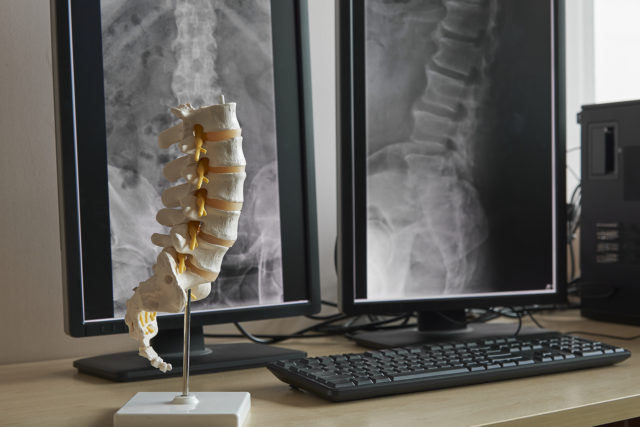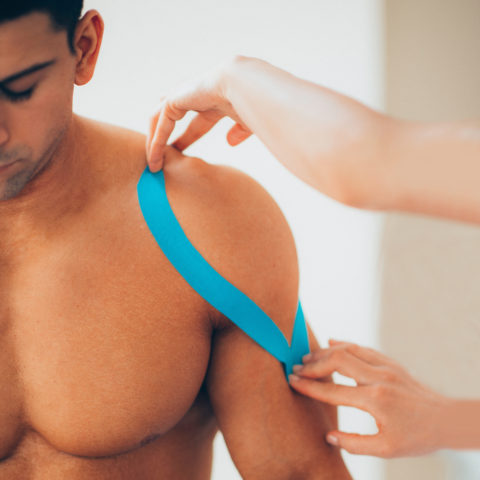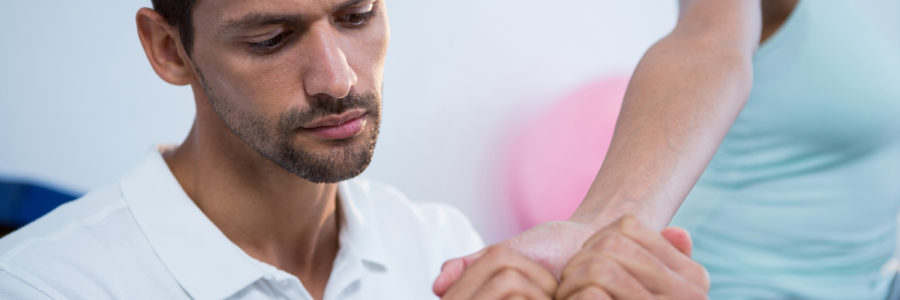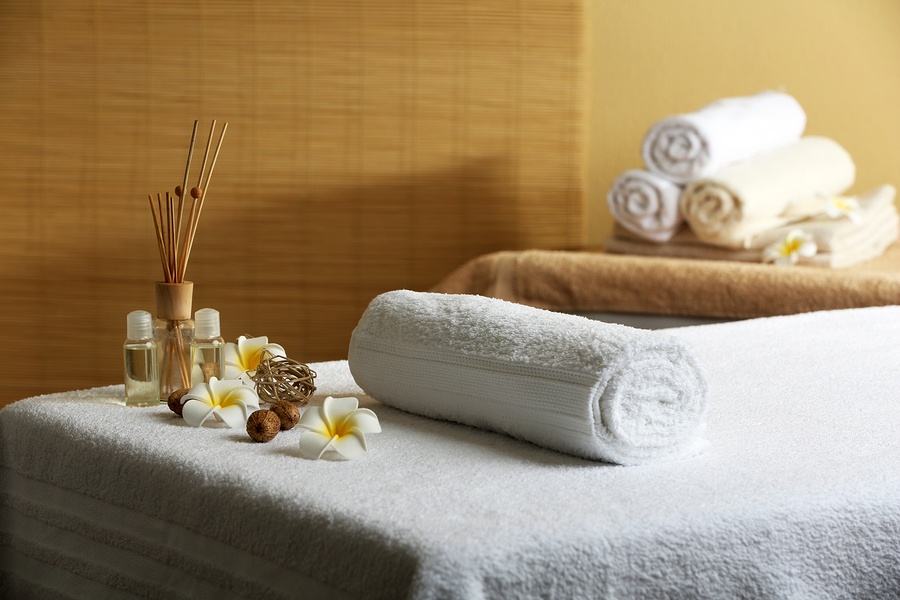
Degenerative disc disease (DDD) is a medical condition where one or more discs in the back lose strength. Despite the name, degenerative disc disease isn’t technically a disease but a progressive condition that worsens over time due to wear and tear, or injury.
The discs in your back are situated in between the vertebrae of the spine and act as cushions and shock absorbers. They help you stand up straight and move through everyday motions, such as bending over or twisting around. As people age, DDD can worsen and cause mild to extreme pain that can interfere with your everyday activities.
Symptoms of Degenerative Disc Disease
Some of the most common symptoms of degenerative disc disease include pain that:
- Primarily affects the lower back
- Could extend to legs and buttocks
- Stretches from neck to arms
- Can be worse from sitting
- Worsens after bending or twisting
- Comes and goes in a few days or extends to several months
People with DDD might exhibit less pain after walking or exercise. Additionally, DDD can cause weakened leg muscles and numbness in your arms or legs.
Causes of Degenerative Disc Disease
DDD is primarily caused by natural wear and tear of spinal discs. Over time, discs tend to dry out and lose their support and function, leading to pain and other symptoms. DDD can start developing in your 30s or 40s and progressively worsen as you age. However, the condition can also be caused by overuse from sports or repetitive activities, or injury. Once a disc is damaged, it can’t repair itself.
Risk Factors
Age is the major risk factor for degenerative disc disease. The discs in between the vertebrae often shrink down and lose their cushiony support as people age. Almost every adult above the age of 60 has some form of disc degeneration. However, not all cases cause pain.
Long-term repetitive activities that place a lot of pressure on certain discs can also increase your risk. Other risk factors include car accidents, overweight or obesity, and a sedentary lifestyle.
Diagnosis of DDD
An MRI can help detect degenerative disc disease. Your doctor may recommend this type of imaging test based on a physical exam or an investigation into your symptoms and health history. Imaging tests can reveal damaged discs and help rule out other triggers of pain. When you receive a diagnosis of DDD, it does not mean that you’re disabled or headed for a downward spiral of spinal degeneration. In fact, DDD is often a part of the natural aging process that we all go through at some point in life. And the good news is that you can mitigate the associated pain through a variety of treatment solutions, including massage therapy.
Massage Therapy Treatment for DDD
From a Massage Therapy point of view, the approach in treating DDD is to strike a balance between reducing muscle tension and enhancing traction (decompressing the targeted vertebral segments). Finding a “green zone” of treatment is critical since the spasms that occur through the neck or low back happen because the body is trying to protect that area. By applying slow, repetitive, methodical massage between soft tissue and joint mobilization (spinal decompression), massage therapy can help relieve pain and allow you to move easier and execute strengthening exercises efficiently.
Massage therapy generally helps in these three ways:
- Increasing Blood Flow and Circulation: Proper blood circulation ensures that critical nutrients flow back fully to the strained muscles and tissues. This makes the muscles/tissues stronger, helping relieve the strain coming from the degenerating discs.
- Decreasing Tension: The muscles can become tense as they struggle to compensate for the weakening discs. When these muscles are manipulated during the massage, they become relaxed, which improves the range of motion and flexibility.
- Increasing the “feel good” chemical: Massage therapy releases Endorphins, a mood-enhancing chemical that is released in the brain. This “feel good” chemical helps in reducing pain and enhancing recovery.
Prognosis Possibilities
Without treatment or therapy, DDD can gradually progress and cause more adverse symptoms. While surgery is a treatment option, other less invasive treatments such as massage therapy have been found to be just as helpful yet less costly. A clinical study involving a 66-year-old female patient with cervical degenerative disc disease in her lateral left facet joint recorded impressive outcomes. The patient was experiencing symptoms of severe neck pain accompanied by restricted cervical range of motion. She also exhibited radicular left shoulder and arm pain. The objective of the study was to determine the effect of therapeutic massage on the patient’s symptoms and impairments of cervical DDD.
After multiple treatment sessions, the patient’s symptoms had decreased and cervical ROM had moderately improved. There was also a reduction in reported pain and an improvement in functional daily activities. This is an indication that massage therapy is a favorable treatment intervention for DDD symptoms.
Bottom Line
Massage can help improve the symptoms associated with Degenerative Disc Disease for a prolonged duration of time as long as you continue to follow the maintenance schedule that your Massage Therapist lays out. Massage therapy typically reduces muscle strain, improves flexibility, and mitigates pain. However, you can achieve the best results by working in conjunction with other health care professionals. Keep open communication between your doctor and your massage therapist to ensure the best treatment.
To learn about becoming a massage therapist in Seattle contact one of the following local massage schools; Northwest Academy for the Healing Arts or Seattle Clinical Massage School

Kinesiology Taping in a Massage Practice

Since the 1970s, athletes have been using kinesiology taping to help them heal faster and build stronger muscles. Therapists have recently started using taping methods to bring those same benefits to their clients. Massage therapists can use taping to prolong relief and increase the body’s natural ability to heal itself.
What is Kinesiology Taping?
Kinesiology studies the body, and how it uses each part to move. Using knowledge of physiology, biomechanics, and psychology, the kinesiologist seeks to improve strength and muscle condition.
Kinesiology tape is a thin, stretchy fabric that adheres to the skin with acrylic adhesives. The adhesive itself is mild on the skin but very strong. The tape is waterproof and can stay in place up to five days. Usually made of brightly colored cotton, it has the same thickness and elasticity of healthy skin. It is designed to not cause any pinching, binding, or restrictions.
When applied to the skin, the tape gently lifts surrounding skin, allowing for a better flow of interstitial and lymph fluids. These fluids help remove dead cells and other waste caused by injury or a hard workout. They also deliver vital nutrients that cells need to repair themselves.
Interstitial fluids are also responsible for facilitating intercellular communication. When muscles cells are able to easily send and receive the electrical impulses that stimulate muscle movement, coordination and flexibility are dramatically increased.
Benefits of Taping
When applied around problematic joints and muscles, taping increases the healing and pain relieving properties gained from other therapy methods.
- Reduce painful inflammation by allowing the removal of cellular waste.
- Reduce pressure on nerve endings by lifting the skin away from pain receptors.
- Relax hypertonic muscles that make proper movement and posture impossible.
- Revive dying or inhibited muscles by restoring needed nutrients and fluids.
Taping allows the body to repair cell damage caused by injury. This allows muscles to restore or improve strength and proper function.
Kinesiology tape is a useful addition in the treatment of many common disorders.
- Sprained or strained muscles and ligaments
- Bruising
- Joint realignment and instability
- Rounded shoulders or spine
- Recently healed fractures
- Tendonitis
- Arthritis
- Fibromyalgia
Taping and Massage Therapy
Patients with chronic conditions benefit most from a combination of massage therapy and taping. When tape is applied after massage:
- Muscles that have been stretched and warmed by massage will stay loose longer.
- The body can remove lactic acid more easily, which decreases soreness after deep tissue techniques.
- Softens scar tissue and fascial adhesions so future sessions can be more productive.
- The natural pain relieving ability of massage will last longer.
- Added stability will keep muscles from moving out of alignment.
Tape can be safely applied to any body part. Different application methods encourage pain relief, structural support, and other therapeutic goals.
Kinesiology taping is an effective addition to any physical therapy routine. It can be used to treat a variety of musculoskeletal disorders and injuries in a noninvasive manner. When therapists add taping as a final touch to their therapy process, clients increase healing, flexibility, and muscles strength while reducing pain, swelling, and possible injury.

5 Important Questions to Ask Every New Massage Therapy Client
 Successful massage therapy begins before your massage therapy client touches the table. A pretreatment client interview will help set expectations, increase the effectiveness of your treatment, and relieve any anxiety on the client’s part.
Successful massage therapy begins before your massage therapy client touches the table. A pretreatment client interview will help set expectations, increase the effectiveness of your treatment, and relieve any anxiety on the client’s part.
Interview Basics
- When clients schedule a first appointment, let them know that you will be conducting a short interview before treatment begins. Ask them to make a list of any questions or concerns and bring it with them.
- Provide a pre-interview questionnaire. Your questions should focus on general health conditions and medical history.
- Have a private space to conduct interviews. Your massage client will be more willing to share personal information.
- Be ready to probe for details. Some clients need to be encouraged to share information about their health.
- Give the client some general information on your practice before you start asking questions. This is especially important for first time massage clients who don’t know what to expect.
Building Trust
A successful therapist-client relationship is based on trust. The client has to believe that you will relieve their pain. Build trust with your client by using active listening skills.
- What is your experience with professional massage therapy? Find out if your client has ever visited a massage therapist. Ask what they liked and didn’t like about it. If they haven’t, ask them what made them decide to come see you. This is a great time to determine and manage expectations.
- How does your pain affect your daily activities? While pain may be a deciding factor, many clients only seek treatment when their pain starts to limit their abilities. Find out what your massage therapy client wants to see happen in their bodies. Use that as a reference point throughout the treatment process.
Finding the Source
Pain or stress relief is the goal of most massage clients. People with long-term, chronic pain issues may have trouble pinpointing the source. Help them guide you with open-ended questions.
- Where does it hurt? Ask the massage therapy client to physically point out problem areas on their bodies. Ask what it feels like. Do the muscles feel tight and sore? Is it more of a stabbing, radiating pain? Offer descriptive words (hot, sore, numb, tingling) to help the client express themselves.
- What do you do for a living? Ask them about their job. Talk about how they sit, stand, or move. Do they take regular breaks? Do they have access to ergonomically correct seating or tools? Ask about sports and hobbies as well. Knowing what muscles they depend on regularly lets you know what major muscle groups to focus on.
Discovering Treatment Options
Every massage therapy client is different. Ask searching questions to tailor your techniques to their specific needs.
What do you do to address the pain? Ask about exercises, self-massage practices, use of heat or ice, or other methods they use for relief. This will help you develop a long-term treatment plan that corrects underlying structural issues. It will also help you decide what techniques you can use for maximum relief.
At the end of the interview, give your client some time to ask questions. Answer them thoroughly and truthfully.
The client interview is an essential part of creating customized treatment plans for your clients. It is also an ideal time to educate them. Asking the right questions before massage begins brings better results and more client satisfaction.
Anatomy of a Massage Session
 Just as the human body has a very specific anatomy that only varies slightly from individual body to the next, so does a massage session. If you are going to become a massage therapist, you might be wondering what the various necessary components are to most standard massage sessions.
Just as the human body has a very specific anatomy that only varies slightly from individual body to the next, so does a massage session. If you are going to become a massage therapist, you might be wondering what the various necessary components are to most standard massage sessions.
- Introduction / Meet & Greet: When your client first walks into your massage environment, you want to present a positive and happy attitude to assist in guiding their energy towards a relaxed and uplifted place.
- Paperwork / Check-In: In most cases, you’re going to want to have your customer fill out a basic worksheet detailing any known medical issues, seeking to learn about the specific pain or discomfort they are experiencing. In this phase, be sure to find out if your client has received professional massage treatment previously and if so, what the frequency of that treatment has been.
- Hand-off / Room Entry: If you are in a larger facility, someone else might be doing the registration process and will then hand off the client to you as the massage therapist. In the case where you are operating a freelance practice or where you are the only person in the studio at the time, you’ll be greeting and welcoming the client to their room.
- Environment Test: While indicating to the customer that it is your goal to make the environment perfect for them, use your own professional guidance to make educated assessments about the state of the studio. Is it drafty? Is it too hot or is the air stagnant? Many environmental issues can be fixed with only minor modifications.
- Manipulate Environment: Make any logical modifications to the massage environment to ensure it is as comfortable to the client as possible.
- Ask Questions: Some clients will appreciate some quiet music or some ambient sounds, while others will want near-complete silence. Ask the client questions about the environment and then depending on the answers, try to give the customer the environment that they request.
- Reiterate Details: Take a moment to repeat the details you’ve received from your client and make sure you didn’t misunderstand anything. By letting the client know they were heard correctly, you prepare them for even greater peace of mind. Make sure you’ve asked them about their trouble areas and what level of pressure they prefer.
- Check Readiness: The final step to ensuring you are entirely on the same page with your client, and once they are fully situated on the massage table ask them if they are prepared to begin. It might seem like a trivial step, but it shows respect and also helps to bring the energy to a relaxed and comfortable place.
- Massage Phase: depending on the type of massage service discussed and desired, begin to give that treatment. While massaging your client, try asking a few questions about the pressure and various other environmental elements to make sure you haven’t gone astray of the client’s wishes.
- Resolve: After the massage, you’ll want to offer your client a glass or bottle of water and some time to get back in order. Leave the massage area and allow them time to put clothing back on and come back to a fully alert state.
Payment collection was not specifically added to this walk-through, due to the fact that it can be inserted in the beginning or the end of the treatment, as preferred by the studio or establishment offering the service. Obviously, this guide is not going to be universally applicable to every single massage studio or institution, but it is a great start.
For additional information about what to expect during a massage session please contact our massage school clinic.





